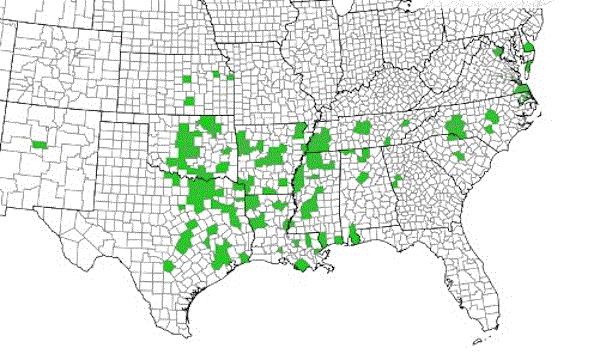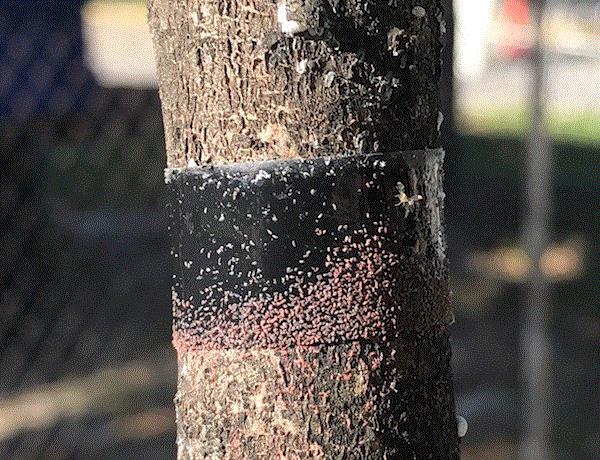Known hosts of crapemyrtle bark scale
I had given two talks about crapemyrtle bark scale (CMBS) to groups of landscape care professionals and pest control operators in the last couple of weeks. There are a couple of similar talks in the next three weeks. There’s a good reason for so much recent coverage of a topic that wasn’t even given a thought in South Carolina a year ago—the invasive scale insect species is spreading in South Carolina and elsewhere in the country. I have to brush up on my knowledge of CMBS to prepare for these talks.

Counties with confirmed infestation of crape myrtle bark scales are shaded green. (Source: EDDMaps)
One of the most commonly asked questions about CMBS that I have to prepare for is “Do they really feed only on crapemyrtles?” Well, no. Crapemyrtle is my greatest concern because it is perhaps the most widely planted, noticeable and damaged host of CMBS. Previous reports from Asia have documented 13 plant species as hosts. In the United States, American beautyberry and St Johnswort also are known to be infested. CMBS also feeds on apple, flowering quince, diamond-leaf persimmon, narrow-leaf heimia, southern crabapple and pomegranate in a greenhouse test. CMBS didn’t infest boxwood, native persimmon, blackberry and raspberry in the same greenhouse study.

Crapemyrtle bark scale preference for beautyberry, fig and spirea
New papers by a team of students and researchers led by Mengmeng Gu have expanded the potential host range of CMBS. I consider Mengmeng one of the world’s leading experts on CMBS. At Texas A&M University, she has built a productive research program on this invasive pest. The greenhouse study mentioned in the previous paragraph is a product of the team. Check out the CMBS program website.
A new study, led by Mengmeng’s Ph.D. student Runshi Xie, was published in HortScience (December 2021, Volume 56, Issue 12). The team collected insects suspected to be CMBS from American beautyberry and Japanese spirea in Arkansas, and Thunberg spirea in North Carolina and sequenced the cytochrome oxidase I (COI) gene of these insects. The genetic sequences confirmed that CMBS could successfully feed and grow on both spirea species as they do on American beautyberry. The team speculated that the infestation in Arkansas and North Carolina originated from nearby, established CMBS populations.

Infestation of crapemyrtle bark scale on Beer’s Black (A) and Chicago Hardy edible fig (B). (Photo credit: Wu et al., HortTechnology, February 2022, 32(1):10-15.)
Another study was published in HortTechnology (February 2022, Volume 32, Issue 1) and was led by another of Mengmeng’s Ph.D. student, Bin Wu. The team initially observed that CMBS could feed on edible figs. To confirm that observation, the team conducted additional greenhouse tests to evaluate the potential of eight beautyberry species and three fig species as hosts of CMBS. The data were compared to a known host, the American beautyberry. Although all beautyberry species and waipahu fig supported CMBS development and should therefore be considered hosts of CMBS, only Issai purple beautyberry, Japanese beautyberry, Alba white-fruit Asian beautyberry and luanta beautyberry were as suitable as Bok Tower American beautyberry in supporting CMBS population growth.

How to manage crapemyrtle bark scale?
Attendees of my talks on CMBS were most interested in knowing what they can do to reduce pest population and damage. I always find ladybeetle larvae, especially those of Hyperaspis species, with CMBS populations in South Carolina. Therefore, I always stress the importance of giving the ladybeetles a chance in suppressing the CMBS population. Mike Merchant of Texas A&M University suggested that ladybeetles can provide about 75% suppression of CMBS population.
Folks also want to know what they can spray to reduce CMBS population. There are two management approaches. Folks can do a soil drench with imidacloprid or dinotefuran when the crapemyrtles are breaking buds. One yearly soil drench application will do well in reducing population. Alternatively, folks can spray insecticides (bifenthrin, dinotefuran, imidacloprid, flupyradifurone, pyriproxyfen, buprofezin or cyantraniliprole) when CMBS population is producing crawlers (or hatchlings). Make a second spray seven or 14 days after the first spray. Usually, two sprays against the first generation in the spring can reduce the CMBS population greatly but you also could choose to spray against every generation to further reduce the population.

Crapemyrtle bark scale crawlers stuck on a homemade sticky trap. (Photo credit: JC Chong)
The crawler emergence time is not known for all states, with the peak emergence of the first generation occurring between mid-March and early May. Remember: timing of crawler emergence changes from place to place and from year to year because of varying temperature. The best way to know precisely when crawlers are emerging in your area is to do sticky tape trapping by wrapping a black electrical tape (sticky side out) around an infested trunk in April (see picture above). Check the tape weekly and spray can start when you found lots of purple crawlers stuck to the tape. Change out the tape when it gets dirty or full of debris or crawlers. You can trap for the crawlers throughout the year to identify the crawler emergence times of all generations.

Visitors of crapemyrtle flowers
Imidacloprid and dinotefuran (both neonicotinoids) are two of the most effective insecticides against CMBS but they are known to have high toxicity against bees and other pollinators. Questions about how soil drench of imidacloprid or dinotefuran against CMBS will impact pollinators that visit the treated crapemyrtles are often asked when I talk about CMBS management.
The risk of an insecticide to a pollinator is a function of interaction between the toxicity of the insecticide and the chance of the pollinator contacting or ingesting the insecticide. We know the amount of imidacloprid and dinotefuran needed to kill a bee. So, the remaining questions to be answered are whether crapemyrtles attract pollinators and whether pollen or nectar of crapemyrtles can be contaminated by imidacloprid and dinotefuran. Several research papers provided some answers to these questions.
The first study was published in 2016 (seems like a long time ago) by Charles Riddle and Russ Mizell of the University of Florida (Florida Entomologist, 2016, 99(1): 38-46). The researchers found that bee species displayed preference for certain cultivars (such as Natchez, Osage and Sioux) but the preference seems to change from year to year. For honey bees, more blooms attracted more bees but trees closest to bee hives didn’t attract more bees than those far away.
The M.S. thesis of Anna Thurmond at Auburn University identified bees, wasps and flies from 10 families visited crapemyrtle plants in five urban and suburban sites near Auburn, Alabama. The busiest chow time on crapemyrtles in Auburn was between 7:30 and 8:30 a.m. More than 60% of the flower visitors were bees, especially honey bees. Crapemyrtles planted in highly urbanized sites had almost four times as many visitors (but similar number of genera or species) as those planted in suburban sites. Anna didn’t offer an explanation for the high numbers of visitors in urban sites; I think perhaps a flowering plant in a sea of concrete serves to concentrate hungry visitors.
Another study published by Taryn Bazhaw and colleagues at Texas A&M University in the Journal of Environmental Horticulture (December 2021, 39(4): 143-149) focuses on honey bees. The researchers found that the cultivars Natchez and Tuscarora attracted more honey bees than Ebony Fire and Pocomoke, which might be a result of more blooms on Natchez and Tuscarora. The researchers also found more honey bees on crapemyrtles than on pollinator friendly plants (such as roses, vitex, rudbeckia, hibiscus and mountain mint) that the researchers had planted nearby. The researchers hypothesized that the honey bees prioritized the collection of pollen from the crapemyrtles over resources from the other plant species during this study (week 27 to 34 of 2019 and week 26 to 35 of 2020).
These studies certainly prompted me to change my story from “I don’t think crapemyrtles are particularly attractive to pollinators,” to “Yes, there are indeed lots of bees and other insects visiting crapemyrtle flowers to collect or feed on pollen.”
Insecticide residue in crapemyrtle pollen
Anna Thurmond’s M.S. thesis also contains an experiment aimed at determining the amounts of neonicotinoid insecticide residues in crapemyrtle pollen. Imidacloprid (Mallet 2F) and dinotefuran (Zylam Liquid) were applied as soil injection at the maximum label rates at three different application times: post-bloom but pre-dormancy (fall), pre-bud break (winter) and post-bud break but pre-bloom (spring). Pollen and leaf samples were collected at first flush after the insecticide treatment and analyzed using liquid chromatography-mass spectrometry (LC/MS).
Imidacloprid and dinotefuran residues were detected in the pollen of crapemyrtles treated at all three times. There are more dinotefuran residues than imidacloprid residues in the pollen, and the average amount of residues (of both neonicotinoids) was lower in crapemyrtles treated in the spring. This thesis research concluded that the level of imidacloprid and dinotefuran residues detected in crapemyrtle pollen could potentially harm pollinators through chronic exposure.
That leaves us with some decisions to make—neonic or no neonic against CMBS? If the decision is to use neonicotinoids, then the application is best made in the spring (after bud break but before bloom) because the efficacy of spring application against CMBS was as high as the fall and winter applications (also a conclusion from another of Anna’s experiments) but the insecticide residues were lower, thus likely having lower risk to pollinators. If the decision is not to use neonicotinoids, luckily, we still have the option of trunk spray with insect growth regulators (buprofezin and pyriproxyfen).





See y'all later!

JC Chong
Professor of Entomology at Clemson University
This e-mail received by 26,984 subscribers like you!
If you're interested in advertising on PestTalks contact Kim Brown ASAP!